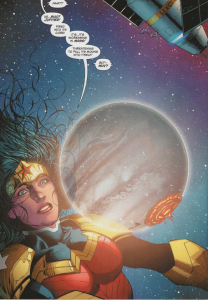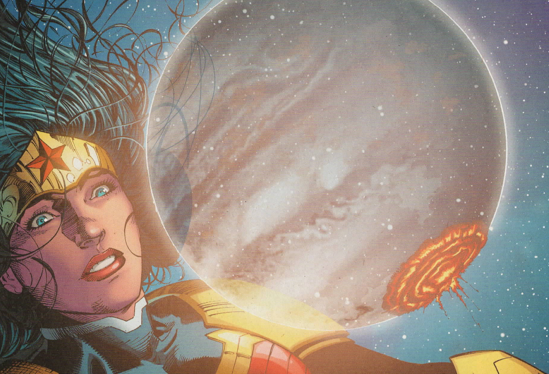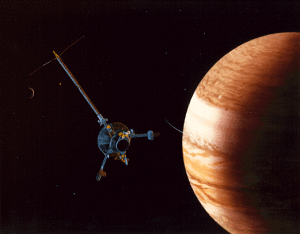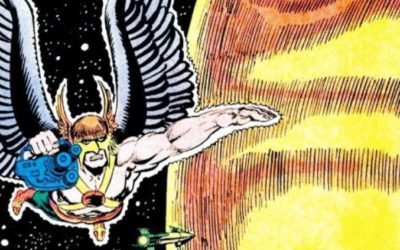 Recently, in DC’s Superman titles (Action Comics, Superman, and Superman/Wonder Woman), Superman and Vandal Savage have been squaring off against each other. Savage, the 50,000 year old immortal (who we talked about as being related to everyone in the DC Universe over here) has been collecting family members and setting a larger plan in motion that …well, is still playing out. He’s captured the Justice League (except Superman and Wonder Woman), transformed some of his “children” into super-powered beings, and, as of Action Comics #49, fired a beam of energy at Jupiter.
Recently, in DC’s Superman titles (Action Comics, Superman, and Superman/Wonder Woman), Superman and Vandal Savage have been squaring off against each other. Savage, the 50,000 year old immortal (who we talked about as being related to everyone in the DC Universe over here) has been collecting family members and setting a larger plan in motion that …well, is still playing out. He’s captured the Justice League (except Superman and Wonder Woman), transformed some of his “children” into super-powered beings, and, as of Action Comics #49, fired a beam of energy at Jupiter.
Why Jupiter? What could he possibly be thinking?
Maybe Savage is thinking something that a lot of people have thought about for a long time. So let’s look at the science of Vandal Savage’s shot in Action Comics #49.
As always, we’re going to look at some particular pieces of this – we’re not trying to make an all-encompassing thesis on this particular storyline point. We’re also not trying to spoil any storylines – we’re just here to talk science.
When it comes to doing things to Jupiter, we’re going to look at two parts, one small and the other…massive.
First – the shot itself. It was energy…or as Savage refers to it, “power,” that has been siphoned from members of the Justice League – Green Lantern, Shazam, Cyborg, Stargirl, Adam Strange, John Henry and others who were shown and/or collected in issues leading up to this issue. The shot was fired in part, in the words of Vandal Savage, “…to finally seize the prize our breed deserves.”
And with a “BRAAKOOOOOM,” the beam is fired from low earth orbit into deep space. A few minutes later, Wonder Woman, who’s hacked into a LexCorp satellite, confirms that the blast has hit Jupiter. Moreover, the blast went into the core of Jupiter and is somehow increasing Jupiter’s mass, threatening to pull its moons into itself.
And that’s where we’ll leave the comics and start some science.
The Road to Jupiter
Let’s start with a simple one. If we assume a beam of energy – we’re assuming electromagnetic in nature – is shot from earth to Jupiter, how long would it take to get there?
That’s an easy physics question. Speed (we can also use velocity, but we’re keeping things really simple here) is equal to distance divided by time. In a formula, it looks like this:
s = d/t, where:
s is the speed of the energy beam,
d is the distance from earth to Jupiter, and
t is the time is takes for the beam to get from earth to Jupiter
Looking up the distance between earth and Jupiter, we get an average value of 4.2 astronomical units. An astronomical unit is the rough distance between the earth and the sun – about 149,600,000 kilometers. So the distance from earth to Jupiter, roughly speaking:
4.2(149,600,000 km) = 628,320,000 km. That’s our value for d.
How fast does an energy beam travel? All electromagnetic energy (gamma rays to radio waves and everything in between) travels at about 300,000 km/second in a vacuum.
We need to rearrange our formula and solve it for time:
t = d/s, or:
t = 628,320,000 km/300,000km/sec.
t = 2094.4 seconds. Dive that by 60 to get minutes, and we get 34.9 minutes. To say it in a slightly cooler way, Jupiter, on average is about 35 light minutes away from earth.
That means, that if you send a signal to Jupiter – a radio signal, a light signal, an x-ray signal, a beam of any kind of known electromagnetic energy, it’s going to take about 35 minutes to get there. Thinking of the future, when we’re talking to our probes and manned missions we’ll one day send to Jupiter’s moon Europa, our messages will take on average, about 35 minutes to reach the probe or crew, and then, with immediate turnaround, an average of 35 minutes to get back. A Europa crew would be at the absolute best, 70 minutes from an answer to a problem, should one arise.
To quote Douglas Adams on it: “Space is big. Really big. You just won’t believe how vastly hugely mindbogglingly big it is. I mean you may think it’s a long way down the road to the chemist’s, but that’s just peanuts to space.”
Space is really big. And things in it, like Jupiter and the sun, can sometimes be really huge.
What’s Jupiter Done to You?
What can be achieved by shooting Jupiter in such a way that its mass increases?
Okay first off, the energy beam increasing the mass of something…thing…? We just need to put that on the shelf. It’s confusing the issue that we’re largely looking at – adding mass to Jupiter. Why would you want to do that?
Again, we’ve got no insight into what might be going on in the current Superman storyline, so what we’re going to talk about from here on out is just speculation at best. But historically – why would people want to add mass and or energy to Jupiter? The idea goes like this: Jupiter is so big that it just needs a nudge to turn it into another star, turning our solar system into a binary star system. Occasionally, you’ll see Jupiter referred to as a “failed star,” which is technically not really true, and on the other hand, really hurts Jupiter’s feelings, because it thinks of itself as a really rocking planet.
The idea goes back a while, but likely found its widest audience in Arthur C. Clarke’s novel, 2010: Odyssey Two. In it, the Monoliths multiply and add their mass to Jupiter (Clarke knew that Jupiter didn’t have enough mass), ultimately causing its core to start a fusion reaction and become a small star named Lucifer. (Clarke’s story was paid homage in the Stargate SG-1 episode called “2010,” which featured a diversion connected to turning Jupiter into a star)
Clarke’s story has helped fuel the notion of Jupiter as the failed second star of our solar system. And don’t get us wrong – it’s an engaging idea – after all, we learn that Jupiter is a “gas giant” in science classes, and it’s really, really big (it has the mass of 318 earths), so could you just pile on some more mass and boom – all that hydrogen starts a fusion reaction like the sun, and just keeps going?
In a word? No. Why? In another word, scale.
No one will argue with you when you tell them that Jupiter is big from our earth-bound frame of reference. Its diameter is 142,800 km. Earth’s is 12,742 km. Jupiter’s volume is 1.4313×1015 km3. Earth’s volume is 1.08321×1012 km3. That’s over 1300 times more volume than earth.
But comparing Jupiter to the sun, we start to get the full picture. The sun’s diameter is 1 million km. The sun’s volume is 1.41 x 1018 km3. Jupiter is, in very rough terms, about a thousandth the size of the sun. You need about…a thousand more Jupiters to approach the mass of the sun. That’s a lot of mass.
A star works by being so big that their gravity confines the mass and creates enough pressure and heat at its core to force two hydrogen atoms (deuterium and tritium, specifically) to fuse together and form a helium atom, and at the same time, release energy and a neutron. If enough deuterium and tritium are packed in a compact enough space, the fusion reaction will keep going and going and going. But the thing is you need a lot of mass. A star’s worth of mass, not a Jupiter’s worth of mass.
 And finding the mass is a serious problem, if you’re trying to get Jupiter to light up. Jupiter has 2.5 more mass than all the planets in the rest of the solar system, so even if you’d valiantly decide to smash everyone else into Jupiter…it wouldn’t work. It’s that big. To build up to 1000 times its mass? We’re not going to say it’s impossible, but it’s so improbable that you can’t tell the difference between it and things that are actually impossible.
And finding the mass is a serious problem, if you’re trying to get Jupiter to light up. Jupiter has 2.5 more mass than all the planets in the rest of the solar system, so even if you’d valiantly decide to smash everyone else into Jupiter…it wouldn’t work. It’s that big. To build up to 1000 times its mass? We’re not going to say it’s impossible, but it’s so improbable that you can’t tell the difference between it and things that are actually impossible.
Okay, so you might remember that our sun is kind of average – average size, average brightness, average everything. What about adding enough mass to Jupiter to make it a smaller star? You’ve got a couple of choices – add anywhere between 10 and 75 more Jupiters’ worth of mass to Jupiter, and you’ll get a brown dwarf star.
Calling a brown dwarf a star is something that it’s mom would do. It’s not really a star, but it wants to think it is. Brown dwarfs occupy the size region between gas giants like Jupiter and small, actual stars. There’s debate on what really make s a brown dwarf a brown dwarf, and in all likelihood, there’s not a firm boundary between the categories on either side. Brown dwarfs may be able to host fusion, but at an extremely low level, allowing them to be seen best with infrared observation.
A rule of thumb is that you need 13 Jupiter masses (of mostly hydrogen) to have enough to start and maintain fusion – mostly likely at the brown dwarf level. Less than 13 Jupiters? No fusion, no star.
After brown dwarfs are red dwarfs, which are actual stars with enough mass and fuel to start and maintain the fusion of hydrogen. Red dwarfs burn cooler than our sun, which means they use up hydrogen at a much slower rate, and as a result, live longer. But to get from a Jupiter to a red dwarf? You’re going to need about 80 more Jupiters to pile on to our own Jupiter. There’s just not enough mass around to do it.
And no, you can’t just light Jupiter and hope for the best. Without any added mass, Jupiter is just not dense enough. Its hydrogen is scattered, relative to a star, so it’s too cold to ignite, and the fuel source for the fusion is spread out too far to maintain any fusion if it even started.
You just need mass. Lots and lots of mass. Mass that we just don’t have in the solar system.
But What If, Man….What If?
Okay – let’s play that game. What if you could add just enough mass to Jupiter to kick it on, say, as a red dwarf? What would the solar system look like?
You’re probably going to kiss Jupiter’s closest moons goodbye. With the increase in mass that you needed to turn Jupiter into a red dwarf you’d also be increasing its gravity on its nearest neighbors, that is, it’s moons. From there outward, everyone else would probably be okay. Probably.
As for the light, if Jupiter was turned on as a red dwarf? At its closest to earth, Jupiter is four times the distance from the earth to the sun, and at its farthest, six times. Any light would be dim at best, not very visible during the day, and at best, it would look like a dim red flashlight at night. Oh, and that light, going back to sending a beam of energy to Jupiter? That would take about 35 minutes to get to earth.
Any impact of Jupiter becoming a red dwarf – would most likely be minimal at best, utterly invisible at worst.
NASA’s Galileo and Lighting Jupiter Up
In 2003, after 14 years in space and 8 years in Jupiter’s system, NASA crashed its Galileo probe into the planet as a means to destroy completely, rather than having it one day crash on one of Jupiter’s moons and possibly contaminate it with bacteria from earth (the probe hadn’t been sterilized prior to its lunch in 1989). On September 21st, Galileo entered Jupiter’s atmosphere at just under 108,000 miles per hour. During Jupiter’s “night,” Galileo dove into the atmosphere just south of the equator in the darkness and was, by all accounts, destroyed.
Leading up to Galileo’s crash, several claims were made that NASA was knowingly risking all life on earth and the solar system due to the spacecraft’s plutonium-238 fuel. According to the conspiracy theory, when entering the atmosphere at tremendous speed (and therefore pressure and temperature) Galileo’s fuel would undergo fission (like an atomic bomb) which would then cascade into a fusion explosion, which would somehow light the planet up, turning it into a star.
Like all good conspiracy theories, this one starts with a few shreds of truth – Galileo did have 50 pounds of plutonium fuel (kept in subcritical amounts), and fission explosions are used to start fusion explosions in hydrogen bombs – and runs away with it. Like most good conspiracy theories, it gets awfully quiet when questions about actual science are asked, such as…well, all that mass stuff earlier.
Since we didn’t have a second sun light up in 2003, its case closed right?
Yeah – not quite. The whole Galileo scenario replayed itself in 2010 when NASA announced plans to do with Cassini and Saturn when it had done with Galileo and Jupiter. This time, conspiracy theorists had a name for it: Project Lucifer.
According to the theories, something went wrong with the Galileo plan to turn Jupiter into a second sun in our solar system, and NASA was looking to try again with Cassini and Saturn. The Cassini probe, launched in 1997, has been in the Saturn system since 2004 taking amazing pictures and even landing its Huygens probe on Saturn’s moon, Titan in 2005.
On September 15, 2017, after a series of close passes, Cassini will enter Saturn’s atmosphere and be destroyed in the same manner as and for the same reasons as Galileo. And the rumors have been swirling since the plan was announced.
But consider – if Jupiter is nowhere near big enough to turn into a star, Saturn, which only has 30% of the mass of Jupiter just isn’t going to cut it. You’d need over 240 Saturn masses to make a red dwarf.
Jupiter (and Saturn) are going to have to remain as they are – planets – big, gas giant planets for the remainder of the solar system’s lifespan. But in the meantime, our planetary family’s biggest members are giving up amazing secrets, and their moons may just have life here and there.
Yeah – let’s not turn Jupiter and Saturn into stars. They’re too interesting as planets.
Update (2/24/16): In the spirit of telling the full story, as it was revealed in Superman/Wonder Woman #26 and Superman #49, Savage’s beam at Jupiter that increased its mass wasn’t about lighting it up like a star. Instead, Savage increased Jupiter’s mass (which brought its moons in closer) to ultimately affect the path of the comet which gave him his powers. By bumping Jupiter’s mass up, it did enough (and quickly enough) to change the orbit of the comet and bring it to where Savage could grab at it with another power beam. Increasing the mass of a planet to alter the path of a comet – hat tip for the creative thinking to the Superman writers this month for their neat use of some real science ideas for a story element.









